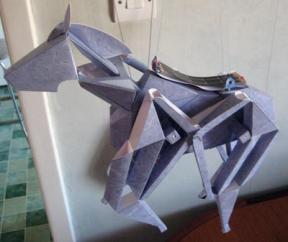Last week I went to visit a maker local to Glasgow: Jim Watt, paper engineer, theremin fancier, 3D photographer and proprietor of clockworkrobot.com.
I discovered Jim's site when his Solar Powered Theremin project was posted to Make (which has subsequently been added it to Maker Shed). Always intrigued by simple musical instruments, I got in contact, discovered we share a city, and Jim very generously let me pop by to chew the fat of making and hacking.

Jim Watt's Kinetic Horse - in solar powered version
Jim has a background in jewellery making and metalwork, and a passion for sci-fi: a combination which led him first into building fantastic robotic sculptures, and on to kinetic engineered paper sculptures inspired by the revived Doctor Who series, which were then picked up and marketed by the Doctor Who people themselves. Meanwhile, a solar powered horse automaton led Jim on to create the solar powered theremin, which has now led to a modular system of synths and sequencers in Altoid tins. Quite a prolific chap, Jim admits to the affliction of being rather fickle, turning his attention to each project that he thinks up with focus and immediacy. Thus I caught him in the excitement of developing his Pocket Synths, though I felt that he could have been ensconced in any other of his many interests if the wind were blowing differently that day.
Jim sells kits through his website and has had a lot of interest in the solar theremins, but is beginning to lament the time and effort that he must put into building the kits - a bit of a mundane chore for such an active mind! A problem that many makers must face, he would like to employ someone to do the legwork of making up kits but is loath to entrust quality control of his very personal projects to another. He feels that he can't put as much time into development, publicity and marketing as he would like for all the production he has to do. I suggest that this is why I find collaboration and open sourcing so exciting: generally all developers are equally passionate about their subject, one can share out the necessary tasks more effectively - however this poses the problem of the 'non-commercial' clause: ultimately the creator has to make their money from production, and in an open model this can't be done without restricting commercialisation in some way. At the end of day, it seems one must be willing to give up some hold over one's creations if one is to share the burden the demand for a successful product.
As it is, Jim's departure into open hardware was a result of disillusionment with the system of patenting and copyrighting. He notes that one can spend much time and money protecting one's IP, yet this still will not protect you from another person plagiarisation unless one can afford to prosecute them: not a situation independent makers generally want to get in to. So Jim makes his schematics and source available for free, and charges for the kits, a model which is working well for him and many others. Amusingly, Jim sells more solar theremin kits with Altoids tins included than without - highlighting makers' desire for convenience (or maybe dislike of Altoids) over economy - but irritating as Altoids aren't really native to the UK, so are a bit weird to be exporting, and meaning Jim always has a steady supply of mints!

A feature of Jim's Pocket Synth system that I enjoyed greatly was the tactility and elegance of the tins as a 'building brick' system - one can arrange one tin in the lid of another, thus making the act of building your synth/sequencer that much more satisfying. This kind of joyful coincidence is only achieved by 'hacking', modding, playing with ideas physically and resourcefully, and thus in danger of being lost in that haptic gap. Additionally, the whole system is executed through the joining of simple electronic elements using patch cables, making the logic of synthesisers much clearer to me than any diagram or standalone synth ever has.
It was great to observe the backstage workings of a modern day maker and kit distributor - many thanks to Jim for having me!



No comments:
Post a Comment